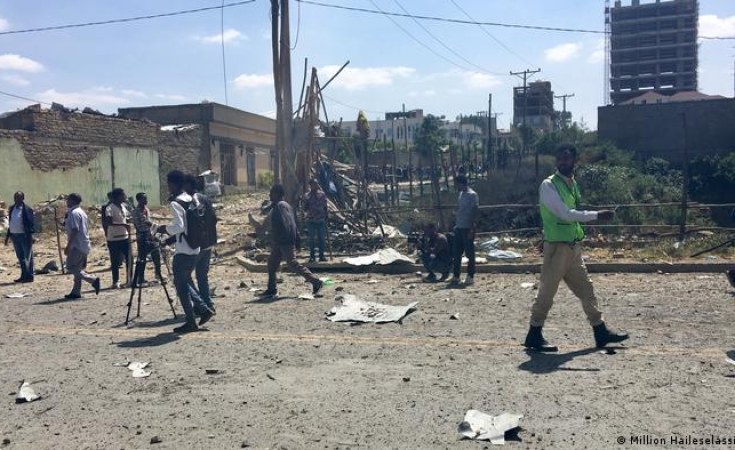In 2021, the number of internally displaced persons (IDPs) in Ethiopia was estimated at more than 5.1 million according to the Internal Displacement Monitoring Centre (IDMC). The country's ongoing civil war, started in November 2020, alone has displaced more than 2 million people in northern Ethiopia and is now moving further down to southwestern parts of the country.
And then, the climate crisis struck. Severe drought is slowly plaguing southern and north-eastern Ethiopia. This year it is estimated that more than 6 million people in the drought affected regions are expected to be in urgent need of humanitarian assistance. According to UNICEF, almost 1 million children in these areas will be severely malnourished due to a combination of drought, ethnic conflicts and economic inflation. Displacement is a multi-causal phenomenon. Climate change affects human mobility and migration mostly indirectly, via its impacts on a range of social, economic and political factors that affect migration decisions and processes. The extent and complexity of the interactions between different factors at different scales mean that it is rarely possible to distinguish individuals for whom one factor is the sole driver.
In the case of Ethiopia, large-scale displacement has historically reflected the balance of power shifted between different ethnic groups. The villagization and resettlement program is a well-known example. Originally designed by the Imperial Government in the late 19th century for the overcrowded population in the Ethiopian highlands, the program became politicized in the mid-1980s under the Derg regime. The program initially aimed to restructure land-use patterns in order to improve agricultural productivity by moving people to newly created villages. It soon turned out to be a calculated attempt to break the insurgency movements by depriving them of their popular base of support, strengthening domestic security against the rebel groups and enhancing political control over rural areas. It mainly focused on relocating people from the cool and dry highlands of Shewa, Tigray and Wello, where the insurgency movements were fierce, to the hot and wet lowlands of Gojjam, Keffa and Wollega. Under the slogan of promoting food security, the villagization and resettlement program was offered as the least bad solution for peasant farmers in northern Ethiopia in the absence of any other practical options. As a result, more than 500,000 people were relocated in the mid-1980s. However, due to the limited consultation, harsh environmental conditions and lack of adequate facilities, more than 5 per cent of the migrants died from starvation and tropical diseases, and almost 15 per cent eventually fled from the new settlements.
The great famine (1984-85) played a key role in the history of the Ethiopian internal migration. The insurgency movements raged in northern Ethiopia whilst the famine was fueled by a series of severe droughts in the early 1980s. The movements were led by the Tigrayan People's Liberation Front (TPLF), the Ethiopian People's Democratic Movement (EPDM) and the Eritrean People's Liberation Front (EPLF), and all sought to overthrow the Derg regime.
The regime manipulated the politics of famine, land management and people's mobility in order to dominate the war - by increasing surplus extraction, expanding state farms through draconian collectivization and transplanting people from the highlands to the lowlands. State-led agricultural farms refused to relieve their peasant members of their allocated obligations during the famine. The peasant farmers often had to sell the emergency relief food supplies to buy food grain from the markets at excessive prices to bear the obligations. These kinds of manipulative policies played a key role in the regime's counter-insurgency measures. In 2022, the question now relates to two specific issues in Ethiopia. The first is how recurring drought affects the migration patterns of peasant farmers in rural areas. The second is the complication presented by the country's ethnic and political crisis and high levels of economic inflation.
Like many other countries in the Global South, Ethiopia is subject to increasingly frequent drought events. In the case of Ethiopia, specific geographical and social conditions - population growth, historical land shortage and hierarchical systems of rural society - are marginalizing the young generation, as my research found in different parts of rural Ethiopia in 2014. Moreover, an increasing number of migrants are moving to the pole city, the Ethiopian capital, Addis Ababa. This is due to interacting factors. The principal factor is the increase in armed conflicts in many parts of the country while Addis Ababa provides comparatively higher levels of security. Economic opportunities and social infrastructure in the capital have also played an important role in the decision of where to move. Meanwhile, there are different layers of legal and administrative barriers in Addis Ababa for migrants to access infrastructure such as housing, water, healthcare and transport.
Ethiopia's history demonstrates how armed conflicts, drought and internal displacement in concert negatively affect people's chances of survival, particularly for those who are most vulnerable. This complex phenomenon calls for an urgent investigation of future mobility patterns of people in the drought-affected areas.
Dr Jin-ho Chung is Research Associate of the Transport Studies Unit (TSU) at the University of Oxford. He is currently working on the Oxford Martin School Programme on Informal Cities, investigating how climate migrants secure access to infrastructure and what risks and conflicts they face in destination areas upon arrival, with the case of Addis Ababa, Ethiopia. Key themes include access to housing, water, healthcare and transport as well as responses from host communities concerning scarce resources and infrastructure. Jin-ho's research focuses on climate change adaptation, human migration/mobility, urban development and social equity. Trained in political ecology and resilience studies, his approach has been interdisciplinary and collaborative, drawing from collaborations with academics, policymakers and civil society, aiming at improving the relationships between science, policy and practice. Jin-ho completed his PhD in Human Geography at University College London (UCL). He is an editorial panel member for Municipal Engineer, which covers the effect of civil engineering on local communities.


